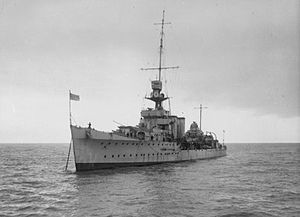
| |
| History | |
|---|---|
| Name | Calcutta |
| Builder | Vickers Limited, Barrow-in-Furness |
| Laid down | 18 October 1917 |
| Launched | 9 July 1918 |
| Commissioned | 28 August 1919 |
| Reclassified | Converted to anti-aircraft cruiser in 1939 |
| Identification | Pennant number: 74 (Aug 19);[1] 82 (Nov 19); I.82 (1936); D.82 (1940)[2] |
| Fate | Sunk 1 June 1941 by air attack off Alexandria, Egypt |
| General characteristics | |
| Class and type | C-class light cruiser |
| Displacement |
|
| Length | |
| Beam | 43 ft 6 in (13.26 m) |
| Draught | 14 ft 3 in (4.34 m) |
| Propulsion |
|
| Speed | 29 knots (54 km/h; 33 mph) |
| Range | Carried 300 tons (950 tons maximum) of fuel oil |
| Complement | 330–350 |
| Armament |
|
| Armour |
|
HMS Calcutta was a C-class light cruiser of the Royal Navy, named after the Indian city of Calcutta. She was part of the Carlisle group of the C class of cruisers. She was laid down by Vickers Limited at Barrow-in-Furness in 1917 and launched on 9 July 1918. Calcutta was commissioned too late to see action in the First World War and was converted to an anti-aircraft cruiser in 1939. Calcutta served during the Norwegian Campaign and the evacuation from Dunkirk in 1940. She was used to escort allied convoys across the Mediterranean and was sunk on 1 June 1941 by Luftwaffe aircraft off Alexandria, Egypt.